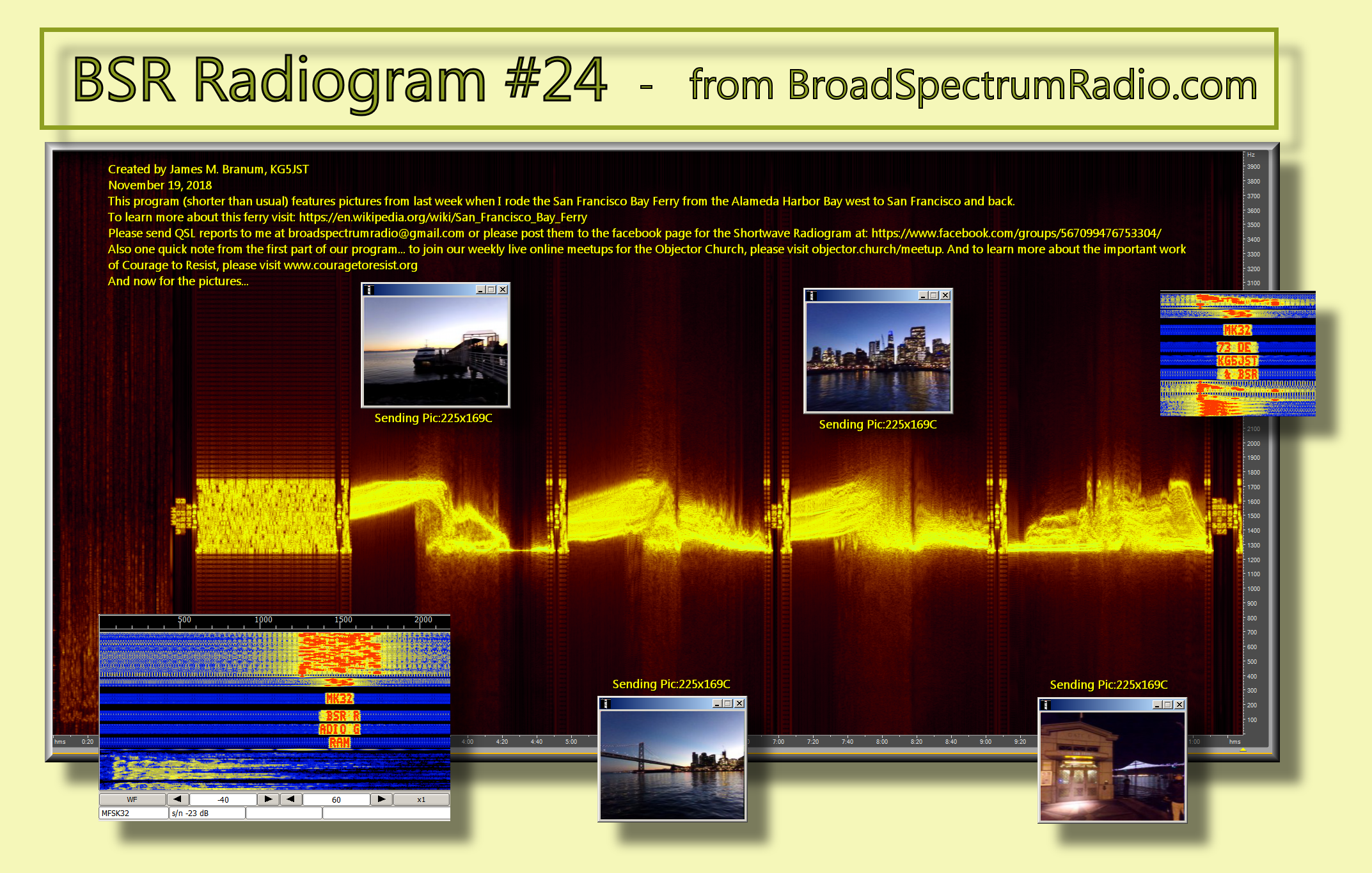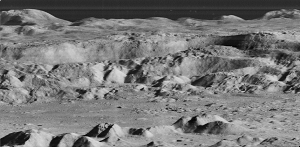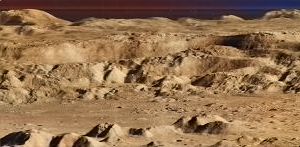http://www.rhci-online.net/radiogram/radiogram.htm

|
RSID: <<2018-11-17T15:25Z
MFSK-32 @
6070000+1500>>
START
IBC - ITALIAN BROADCASTING
CORPORATION
mail:
ibc@europe.com
http://www.ibcradio.webs.com
FB: @ITALIANBROADCASTINGCORPORATION
TW: @RADIOIBC
"IBC DIGITAL" "IBC DIGITAL"
===============
* 4 2 5 D X N E W S *
** DX INFORMATION **
===============
Edited by I1JQJ & IK1ADH
5R - Alex, K2BB and Pavel, UU0JR will be active as 5R8UM from Nosy Be
(AF-057), Madagascar on 19-29 November, including an entry in
the CQ
WW DX CW Contest. Plans are to be QRV on 160-6 metres CW, SSB,
FT8
and JT65A. They will also give 6m EME a try. QSL via Club
Log's
OQRS and LoTW. See
https://5r8-2018.com/ for updates.
5U - Pierre, HB9AMO (http://www.hb9amo.net/)
will be active as 5U9AMO
from Niamey, Niger from 20 November to 3 December. He will
operate
CW on 160-10 metres, including participation in the CQ WW DX
CW
Contest. QSL via M0URX's OQRS and LoTW.
C6 - Rich, N0HJZ will be active as C6ARW from Grand Bahama (NA-080) on
20-28 November. He will be competing full time in the CQ WW
DX CW
Contest; operation outside the contest will be on SSB, CW and
RTTY.
QSL via LoTW or direct to N0HJZ.
DU - Audie, DU1ZDR and Gazelle, DU1ZDQ will be active as DZ1A/DU2 from
Basco, Batan Island (OC-093) on 19-20 November. Main
frequencies
will be 14260 and 7055 kHz.
P4 - Frank, PH2M, will be active holiday style as P4/PH2M from Aruba
(SA-036) on 17-29 November. He will operate SSB and FT8 on
80-10
metres. QSL via LoTW, or via home call (direct or bureau).
PJ4 - Scott, W4PA and others will participate in the CQ WW DX CW Contest
as PJ4Q from Bonaire (SA-006). There will be some
"pre-contest
activity" by PJ4/W4PA starting on 18 November, with a focus
on 160,
30, 17 and 12 metres. QSLs via W4PA.
V2 - Bud, AA3B will be active again as V26K from Antigua (NA-100) on
19-26 November. He will operate mainly CW, and will
participate in
the CQ WW DX CW Contest. QSL via LoTW, Club Log's OQRS, or
via AA3B
(direct or bureau).
V4 - Andy, N2NT will be active as V47NT from St Kitts (NA-104) on 16-23
November, and as V47T during the CQ WW DX CW Contest. QSLs
via
LoTW, or via W2RQ.
VP2E - Rich, KE1B as VP2EAQ and Anna, W6NN as VP2EAR will be active again
from Anguilla (NAh. They will operate CW,
SSB, RTTY and FT8 on 40-6 metres. QSLs via Club Log's OQRS,
LoTW
and eQSL, or via home calls.
"IBC DIGITAL" "IBC DIGITAL"
END END
|
 |

RSID: <<2018-11-17T13:30Z
MFSK-64 @
11600000+1500>>
A close-up of the dial of the Tecsun PL-310ET used by Miguel in
Saltillo, Coahuila, Mexico, to tune in The Mighty KBC ...
Sending Pic:150x81C;
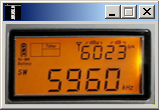
See the rest of the photo:
https://www.kbcradio.eu/index.php?dir=gallery
Please report decode to
themightykbc@gmail.com
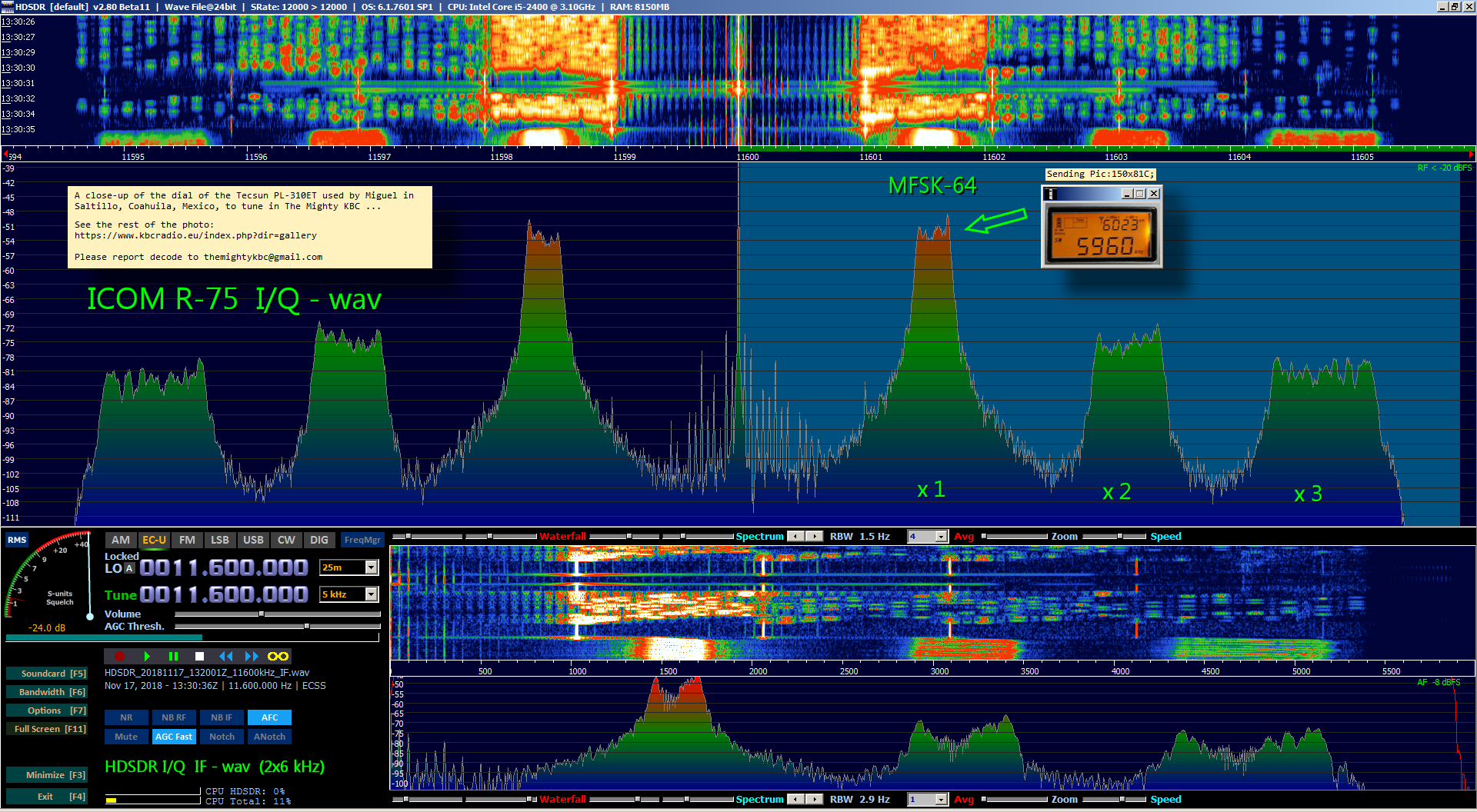
t

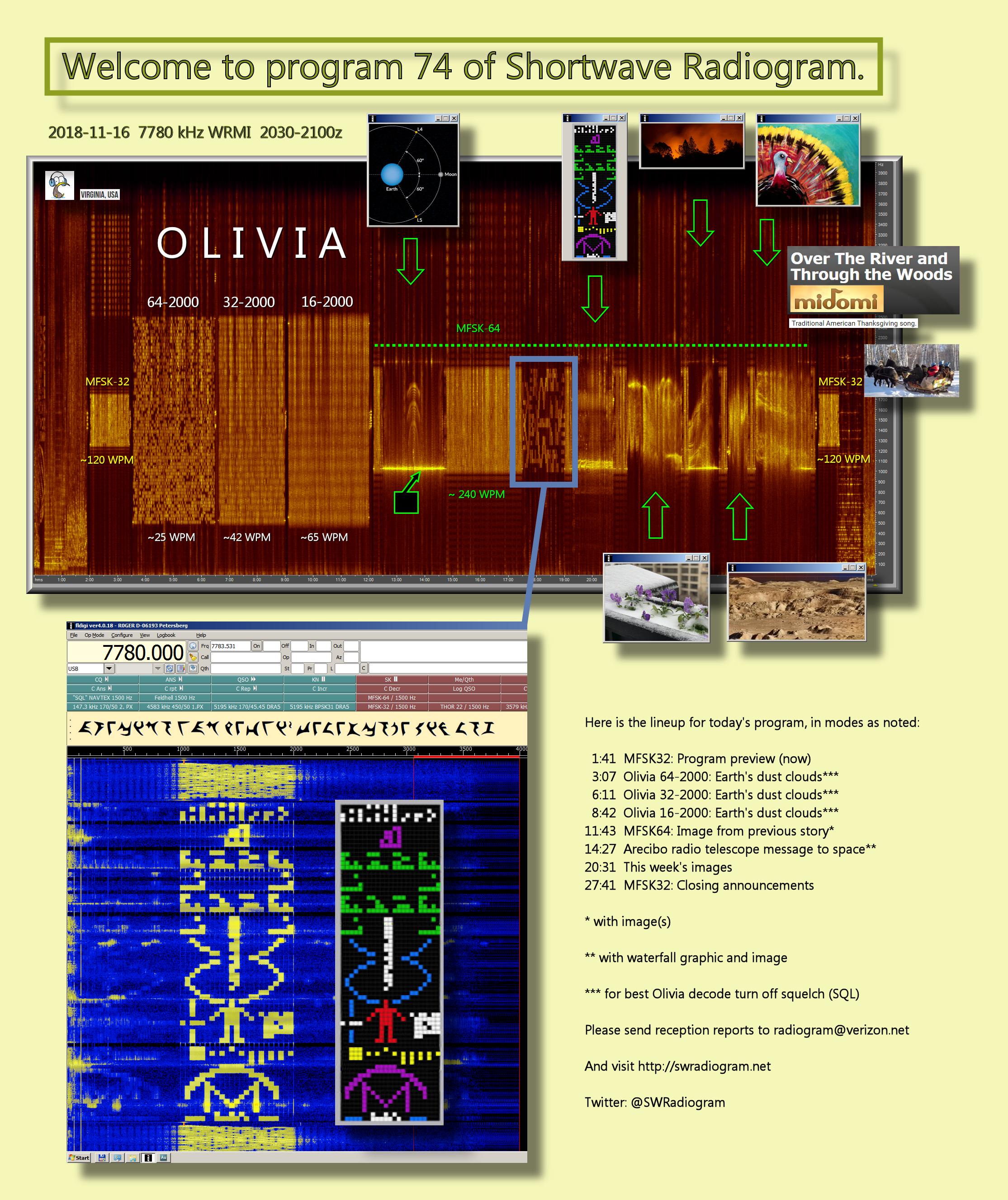
RSID: <<2018-11-16T20:31Z
MFSK-32 @
7780000+1500>>
Welcome to program 74 of Shortwave Radiogram.
I'm Kim Andrew Elliott in Arlington, Virginia, USA.
Here is the lineup for today's program, in modes as noted:
1:41 MFSK32: Program preview (now)
3:07 Olivia 64-2000: Earth's dust clouds***
6:11 Olivia 32-2000: Earth's dust clouds***
8:42 Olivia 16-2000: Earth's dust clouds***
11:43 MFSK64: Image from previous story*
14:27 Arecibo radio telescope message to space**
20:31 This week's images
27:41 MFSK32: Closing announcements
* with image(s)
** with waterfall graphic and image
*** for best Olivia decode turn off squelch (SQL)
Please send reception reports to
radiogram@verizon.net
And visit http://swradiogram.net
Twitter:
@SWRadiogram
Shortwave Radiogram now changes to Olivia 64-2000 ...
RSID: <<2018-11-16T20:33Z
OL 64-2K @
7780000+1500>>
This is Shortwave Radiogram in Olivia 64-2000 ...
From Science News:
One of Earth's shimmering dust clouds has been spotted at last
Lisa Grossman
13 November 2018
Meet the Kordylewski dust clouds, shimmering pseudo-satellites
that orbit Earth near the moon. A team of Hungarian astronomers
say they have spotted light scattered from one of these clouds,
providing evidence that the clouds really exist after nearly 60
years of controversy.
Changing to Olivia 32-2000 ...
RSID: <<2018-11-16T20:36Z
OL 32-2K @
7780000+1500>>
This is Shortwave Radiogram in Olivia 32-2000 ...
The twin dust clouds gather at two of the points in space where
the gravity of Earth and the moon cancel each other out. That
gravitational stability makes these spots, called Lagrange
points, good places to park spacecraft. They also could trap
interplanetary debris.
No one had seen any dust clouds since 1961, when Polish
astronomer Kazimierz Kordylewski reported the first sighting at
two gravity holes, L4 and L5. Some astronomers thought that the
sun's stronger gravity would periodically sweep dust out of L4
and L5, making it hard for the areas to support clouds.
Changing to Olivia 16-2000 ...
RSID: <<2018-11-16T20:38Z
OL 16-2K
@
7780000+1500>>
This is Shortwave Radiogram in Olivia 16-2000 ...
Astronomers Judit Slíz-Balogh, András Barta and Gábor Horváth,
all of Eötvös Loránd University in Budapest, looked for the
clouds using specially designed filters. These filters detect
light that's been polarized, or had its electromagnetic waves
aligned, by bouncing around the dust grains.
The team spent several months making observations in
Slíz-Balogh's private observatory in the western Hungarian
village of Badacsonytördemic. "It is hard to find moonless and
cloudless good nights in Hungary," the astronomers write in a
paper set to be published in January in the Monthly Notices of
the Royal Astronomical Society. But the team finally spotted a
telltale shimmer at L5. The physics of the Lagrange points
suggests that, if one cloud exists, the other does, too. The trio
still wants to search for the L4 cloud directly.
Computer simulations suggest L4 and L5 are only partially stable,
the team reports in a paper in the Nov. 11 MNRAS. The clouds may
hang around for years or decades, but the sun's gravity will
eventually scatter them into space. That could explain the "now
you see it, now you don't" results of past searches for the
clouds, the team says.
https://bit.ly/2FlCzzb
Changing to MFSK64 ...
RSID: <<2018-11-16T20:41Z
MFSK-64
@
7780000+1500>>
This is Shortwave Radiogram in MFSK64
Please send your reception report to radiogram@verizon.net
Image (from the previous news story): The L4 and L5 Lagrange
points between Earth and the moon, forming equilateral triangles
with the Earth and the moon ...
Sending Pic:196x224C;
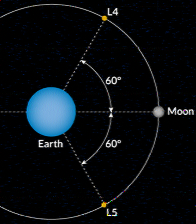
This is Shortwave Radiogram
Please send your reception report to
radiogram@verizon.net
Our listener and contributor Merkouris, SV2HWM, in Greece,
writes:
Last week the Arecibo
Observatory in Puerto Rico conducted
its latest Ionospheric
heating campaign using HF. Most, if
not all, of the
experiments were conducted on 5095 kHz,
resulting in excellent
reception in Greece during the hours
of darkness. According to
a tweet by Dr. Chris Fallen,
researcher at the
University of Alaska Fairbanks, which
operates HAARP, the net
HF power of the Arecibo's heater
was about 460 kW with 22
dB gain at 5.1 MHz.
Two videos of the
transmitted signals, as they were received
here in Greece, can be
viewed at my @SV2HWM twitter account:
https://bit.ly/2PYw1KI
and
https://bit.ly/2B4v2jS
For this broadcast, Merkouris formatted this Wikipedia
article about the renowned message that was sent from Arecibo
into space in 1974 ...
From Wikipedia, the free encyclopedia:
The Arecibo message is a 1974 interstellar radio message carrying
basic information about humanity and Earth sent to globular star
cluster M13 in the hope that extraterrestrial intelligence might
receive and decipher it. The message was broadcast into space a
single time via frequency modulated radio waves at a ceremony to
mark the remodeling of the Arecibo radio telescope in Puerto Rico
on 16 November 1974. The message was aimed at the current
location of M13 some 25,000 light years away because M13 was a
large and close collection of stars that was available in the sky
at the time and place of the ceremony. The message consisted of
1,679 binary digits, approximately 210 bytes, transmitted at a
frequency of 2,380 MHz and modulated by shifting the frequency by
10 Hz, with a power of 450 kW. The "ones" and "zeros" were
transmitted by frequency shifting at the rate of 10 bits per
second. The total broadcast was less than three minutes.
Dr. Frank Drake, then at Cornell University and creator of the
Drake equation, wrote the message with help from Carl Sagan,
among others. The message consists of seven parts that encode the
following (from the top down):
1. The numbers one (1) to ten (10)
2. The atomic numbers of the elements hydrogen, carbon, nitrogen,
oxygen, and phosphorus, which make up deoxyribonucleic acid
3. The formulas for the sugars and bases in the nucleotides of
DNA
4. The number of nucleotides in DNA, and a graphic of the double
helix structure of DNA
5. A graphic figure of a human, the dimension (physical height)
of an average man, and the human population of Earth
6. A graphic of the Solar System indicating which of the planets
the message is coming from
7. A graphic of the Arecibo radio telescope and the dimension
(the physical diameter) of the transmitting antenna dish
Since it will take nearly 25,000 years for the message to reach
its intended destination (and an additional 25,000 years for any
reply), the Arecibo message is viewed as a demonstration of human
technological achievement ...
Full article at https://bit.ly/1RouTcP
Merkouris also created "an audio file which reproduces the
graphic representation of the Arecibo message on the waterfall of
any SDR or decoding software. Best results, i.e. correct aspect
ratio, can be obtained with Fldigi with the normal speed setting."
Also zoom in on your SDR spectrum display for a good view of the
graphic representation.
Merkouris's audio follows ...
.
.
.
.
.
.
Next is an image of the message transmitted from Arecibo in 1974
-- with color added to highlight its separate parts. The actual
binary transmission carried no color information ...
Sending Pic:100x300C;
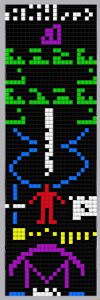
This is Shortwave Radiogram
Please send your reception report to
radiogram@verizon.net
This week's images ...
On Thursday, as I was producing this episode of Shortwave
Radiogram, we had snow, and sleet, and freezing rain, here in the
Washington DC area. From
bit.ly/2DGjeH5 ...
Sending Pic:228x171C;

A view of the deadly and destructive Camp Fire in California.
From wapo.st/2QGcV9u ...
Sending Pic:225x97C;

Some old high-resolution photos of the moon have recently become
available. From
go.nasa.gov/2zbXv63 . See also
bit.ly/2QMFOkf ...
Sending Pic:300x147;
Here in the USA, Thanksgiving will be celebrated 22 November.
Painting from
bit.ly/2Q2FSiM ...
Sending Pic:223x179C;

Shortwave Radiogram now changes to MFSK32 ...
RSID: <<2018-11-16T20:57Z
MFSK-32 @
7780000+1500>>
This is Shortwave Radiogram in MFSK32 ...
Transmission of Shortwave Radiogram is provided by:
WRMI, Radio Miami International, http://wrmi.net
and
Space Line, Bulgaria, http://spaceline.bg
Please send reception reports to
radiogram@verizon.net
And visit http://swradiogram.net
Twitter:
@SWRadiogram
I'm Kim Elliott. Please join us for the next Shortwave
Radiogram.
http://www.rhci-online.net/radiogram/radiogram.htm

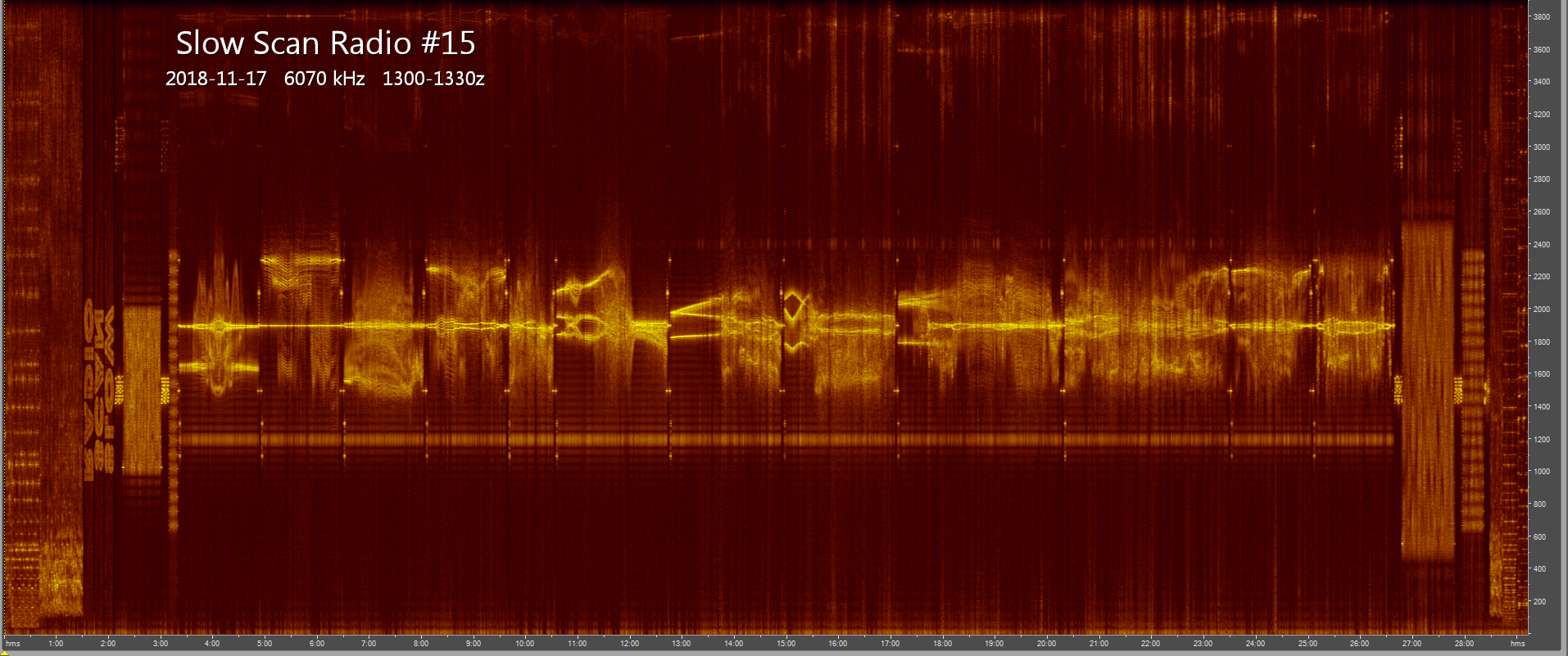
RSID: <<2018-11-17T13:03Z
MFSK-64 @
6070000+1500>>
RSID: <<2018-11-17T13:03Z
MFSK-64 @
6070000+1500>>
Slow Scan Radio November 17, 2018, Episode 15
Last week we abruptly switched from Wednesday evening to Saturday afternoon.
Last Wednesday was the third week in row that the show could not be received by
most Dutch listeners, this is where most of our listeners are.
The new time slot is lot's better for reception in the Netherlands. At the same
moment we regret very much that listeners that are at a greater distance will
probably experience a weaker signal, but this was the only solution to keep many
of our Dutch listeners
involved with the show.
Slow Scan Radio however is a European show. If many listeners can't hear the
show in the new time slot, we will have to think of a solution for that as well.
This week we have 12 pictures, varying from PD50 (320 x 256, 50 secs.) to PD180
(640 x 496, 187 secs.)
--
After the pictures you will find a list of what's in the pictures and copyright
info.
--
de PA0ETE k
RSID: <<2018-11-17T13:04Z
20xPSK63R @
6070000+1500>>
RSID: <<2018-11-17T13:04Z
20xPSK63R @
6070000+1500>>
Slow Scan Radio November 17, 2018, Episode 15
Last week we abruptly switched from Wednesday evening to Saturday afternoon.
Last Wednesday was the third week in row that the show could not be received by
most Dutch listeners, this is where most of our listeners are.
The new time slot is lot's better for reception in the Netherlands. At the same
moment we regret very much that listeners that are at a greater distance will
probably experience a weaker signal, but this was the only solution to keep many
of our Dutch listeners
involved with the show.
Slow Scan Radio however is a European show. If many listeners can't hear the
show in the new time slot, we will have to think of a solution for that as well.
This week we have 12 pictures, varying from PD50 (320 x 256, 50 secs.) to PD180
(640 x 496, 187 secs.)
--
After the pictures you will find a list of what's in the pictures and copyright
info.
--
de PA0ETE k
RSID: <<2018-11-17T13:27Z
MFSK-128 @
6070000+1500>>
RSID: <<2018-11-17T13:27Z
MFSK-128 @
6070000+1500>>
Description of the pictures and copyright info
#1
RCA ’808’ Power Vacuum Tube
Copyright info: Public domain
Author: 池田正樹 masaki ikeda
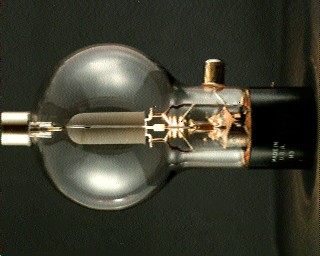
#2
Vacuum electronic device. The exhibit of the Polytechnic Museum. Moscow.
Copyright info: Licensed under the Creative Commons Attribution 4.0
International license.
Author: AlixSaz
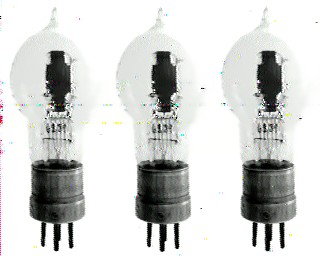
#3
Tungsram commercial vacuum tubes from the 1970's
Copyright info: Licensed under the Creative Commons Attribution-Share Alike 4.0
International license.
Author: Kunszabo
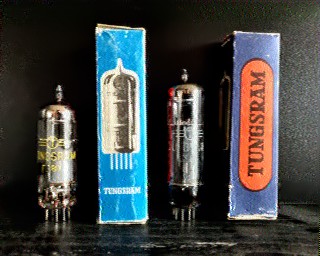
#4
Radio vacuum tube EABC80
Copyright info: Licensed under the Creative Commons Attribution-Share Alike 3.0
Unported license.
Author: 32bitmaschine

#5
This is the Span 27 Railroad Trestle Bridge. It allows trains to pass over a
gulch on which is located Highway 12, just southwest of Minot, North Dakota.
Copyright info: licensed under the Creative Commons Attribution-Share Alike 3.0
Unported license.
Author: Beluga323
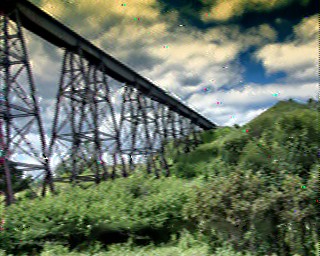
#6
Forth Rail Bridge from South Queensferry
Copyright info: GNU Free Documentation License, Version 1.2 or any later version
Author: Andrew Bell
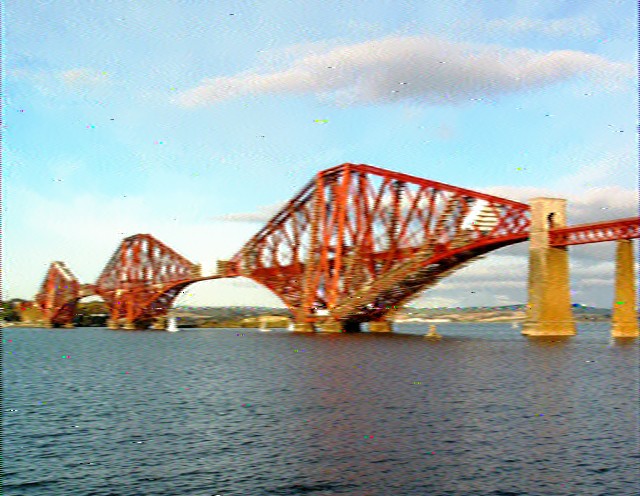
#7
Viaduct of Belgian town Moresnet
Copyright info: Licensed under the Creative Commons Attribution-Share Alike 3.0
Unported license.
Author: G Keuning
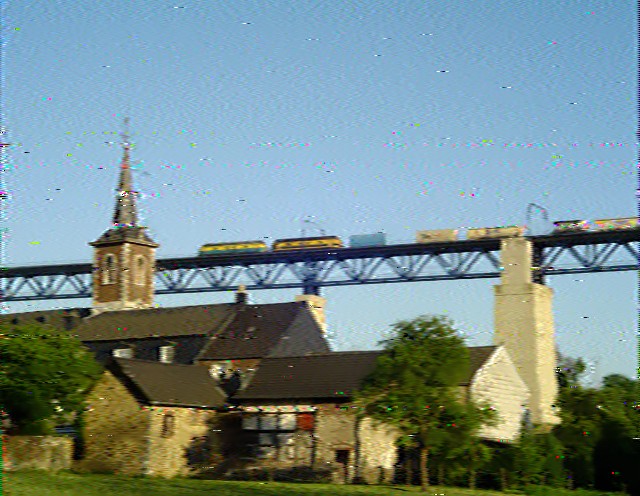
#8
Goat Canyon train trestle
Copyright info: Licensed under the Creative Commons Attribution-Share Alike 4.0
International license.
Author: Ian2001
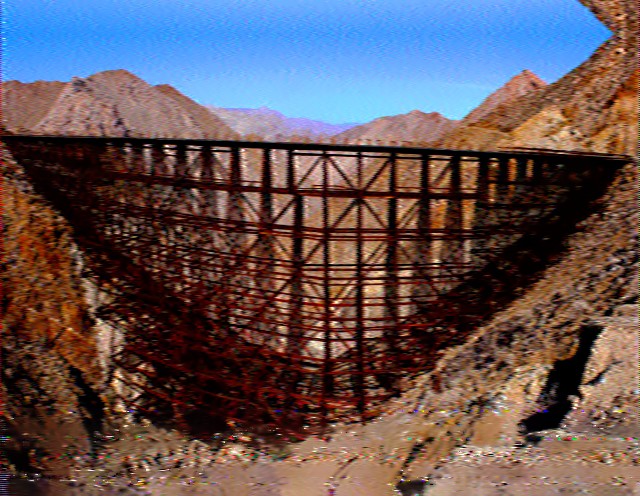
#9
Western facade of Schloss Falkenlust in Brühl, North Rhine-Westphalia, Germany.
Copyright info: Licensed under the Creative Commons Attribution-Share Alike 4.0
International license.
Author: Martin Falbisoner
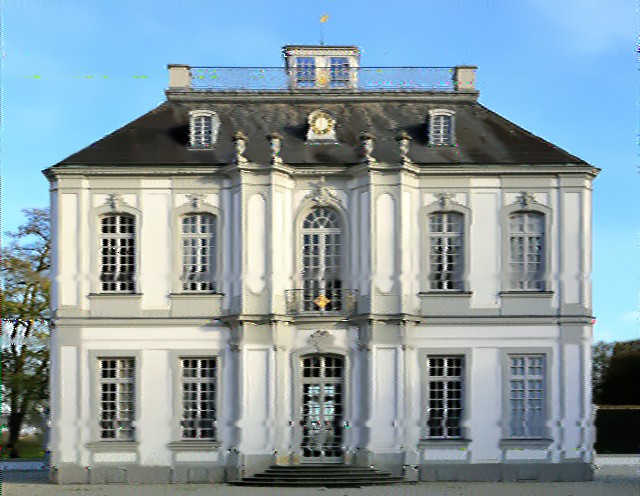
#10
Models (or "booth babes") intended to rev up the engines of attendees are
commonplace among car audio exhibitors.
Copyright info: Licensed under the Creative Commons Attribution 2.0 Generic
license.
Author: Intel Free Press

#11
Radio vacuum tubes - ECC85, EL84, EABC80.
Copyright info: Licensed under the Creative Commons Attribution-Share Alike 3.0
Unported
license.
Author: 32bitmaschine
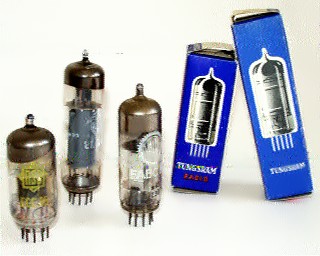
#12
USSR stamp: One of the First Soviet Radio Tubes and Old Building of Nizhny
Novgorod Radio Laboratory. Series: 50th First Soviet Anniversary of Nizhny
Novgorod Radio Laboratory.
Copyright info: This work is not an object of copyright according to article
1259 of Book IV of the Civil Code of the Russian Federation No. 230-FZ of
December 18, 2006.
Author: USSR Post, scanned 600 dpi by Matsievsky from personal collection
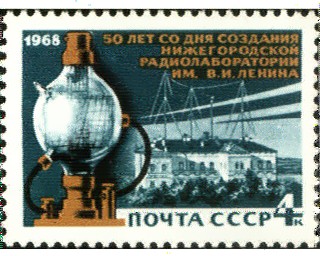
de PA0ETE k
RSID: <<2018-11-17T13:28Z
20xPSK63R @
6070000+1500>>
RSID: <<2018-11-17T13:28Z
20xPSK63R @
6070000+1500>>
Description of the pictures and copyright info
#1
RCA ’808’ Power Vacuum Tube
Copyright info: Public domain
Author: 池田正樹 masaki ikeda
#2
Vacuum electronic device. The exhibit of the Polytechnic Museum. Moscow.
Copyright info: Licensed under the Creative Commons Attribution 4.0
International license.
Author: AlixSaz
#3
Tungsram commercial vacuum tubes from the 1970's
Copyright info: Licensed under the Creative Commons Attribution-Share Alike 4.0
International license.
Author: Kunszabo
#4
Radio vacuum tube EABC80
Copyright info: Licensed under the Creative Commons Attribution-Share Alike 3.0
Unported license.
Author: 32bitmaschine
#5
This is the Span 27 Railroad Trestle Bridge. It allows trains to pass over a
gulch on which is located Highway 12, just southwest of Minot, North Dakota.
Copyright info: licensed under the Creative Commons Attribution-Share Alike 3.0
Unported license.
Author: Beluga323
#6
Forth Rail Bridge from South Queensferry
Copyright info: GNU Free Documentation License, Version 1.2 or any later version
Author: Andrew Bell
#7
Viaduct of Belgian town Moresnet
Copyright info: Licensed under the Creative Commons Attribution-Share Alike 3.0
Unported license.
Author: G Keuning
#8
Goat Canyon train trestle
Copyright info: Licensed under the Creative Commons Attribution-Share Alike 4.0
International license.
Author: Ian2001
#9
Western facade of Schloss Falkenlust in Brühl, North Rhine-Westphalia, Germany.
Copyright info: Licensed under the Creative Commons Attribution-Share Alike 4.0
International license.
Author: Martin Falbisoner
#10
Models (or "booth babes") intended to rev up the engines of attendees are
commonplace among car audio exhibitors.
Copyright info: Licensed under the Creative Commons Attribution 2.0 Generic
license.
Author: Intel Free Press
#11
Radio vacuum tubes - ECC85, EL84, EABC80.
Copyright info: Licensed under the Creative Commons Attribution-Share Alike 3.0
Unported
license.
Author: 32bitmaschine
#12
USSR stamp: One of the First Soviet Radio Tubes and Old Building of Nizhny
Novgorod Radio Laboratory. Series: 50th First Soviet Anniversary of Nizhny
Novgorod Radio Laboratory.
Copyright info: This work is not an object of copyright according to article
1259 of Book IV of the Civil Code of the Russian Federation No. 230-FZ of
December 18, 2006.
Author: USSR Post, scanned 600 dpi by Matsievsky from personal collection
de PA0ETE k
RSID: <<2018-11-17T13:29Z
Feld Hell @
6070000+1500>>


BSR Radiogram #24
from BroadSpectrumRadio.com
Created by James M. Branum, KG5JST
November 19, 2018
This program (shorter than usual) features pictures from last week when I rode
the San Francisco Bay Ferry from the Alameda Harbor Bay west to San Francisco
and back.
To learn more about this ferry visit:
https://en.wikipedia.org/wiki/San_Francisco_Bay_Ferry
Please send QSL reports to me at
broadspectrumradio@gmail.com or please post them to the facebook page for
the Shortwave Radiogram at:
https://www.facebook.com/groups/567099476753304/
Also one quick note from the first part of our program... to join our weekly
live online meetups for the Objector Church, please visit
objector.church/meetup. And to
learn more about the important work of Courage to Resist, please visit
www.couragetoresist.org
And now for the pictures...
